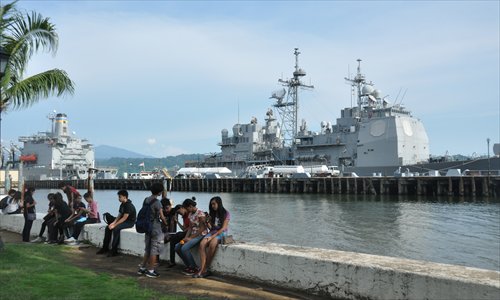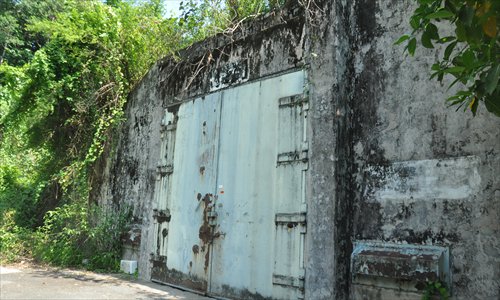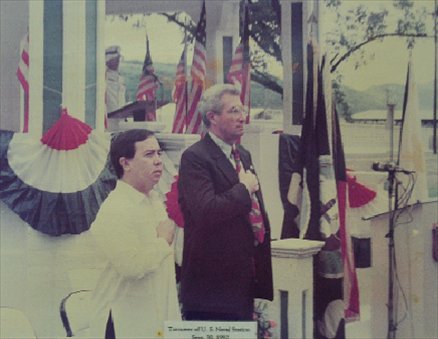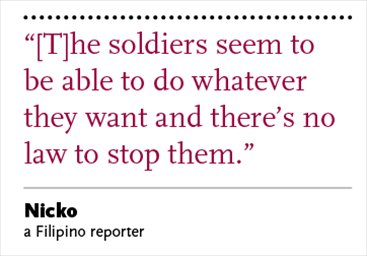The Philippines risks 'becoming a big US military base' amid sea tensions: observer
Recently, military cooperation between the US and the Philippines has increased, with the most clear example being the growing US military presence in Philippine military bases - some of which used to be the US's own bases. Even though the Philippine public is pro-US in general, some are worried that the growing American presence may increase tensions in the South China Sea region.

Locals sit in front of bay where an American naval vessel is docked. Photo: Zhang Yiqian/GT
Of all the highly contentious points of argument around the South China Sea, the old US naval base in Subic Bay is unknown to most people. The former base, about 100 kilometers southwest of the Philippine capital Manila, used to be one of the largest American naval bases in the region. Now, where warships used to dock, tourists and locals chill on beaches and eat in cafes that used to be military offices.
But Subic Bay - which still hosts a smaller Philippine naval base - has caused protests, as some have suggested allowing the US to station troops in more and more Philippine bases as their presence ramps up again in the face of the South China Sea dispute.
Even though the public has a favorable view of the US, some experts, organizations and media outlets in the country are skeptical about the US military's presence.

An old bunker stands in a small street. Many bunkers used by the US military in the past are now storage areas or restaurants. Photo: Zhang Yiqian/GT
American influence
In 1899 Subic Bay was taken over by the Americans from Spanish colonialists and was turned into a major military base as its natural harbor provides a perfect staging post for warships and submarines.
The Philippine government took over the base in 1992 when it and the US agreed to close all American military bases in the country. Back then, there had been a surge of nationalism in the Philippines that led to calls for an end to the US presence, which had dominated the Philippines for decades. The government opened parts of Subic Port up to foreign investment and developed some of the facilities for tourism and business.
Nowadays, tourists come from all over the world to see Subic Bay's natural forests, traditional culture and one of the world's largest aquariums.
Many visitors do not even realize that it used to be a US military base. But the signs are there if you know to look for them.
While touring the area, the Global Times reporter noticed that some of the office buildings and warehouses in the area look much older than others, a hint that they stood here long before the area was opened to civilian investment.
One local landmark, known as No.299, used to be a US admiral's office. It has aged green-and-white walls inside, and electric wires coil together on the ceiling. Old photos of the handover to Philippine control in 1992 hang on the wall. Right now, the building is used as a police station.
There are also some old bunkers in the area that are now storage units or restaurants.
By the bay, the Global Times reporter also spotted an American Ticonderoga-class cruiser. Locals said the ship is there for repairs and they are all used to seeing US naval vessels at the parts of Subic Bay which are now a Philippine naval base. US vessels still cooperate with the Philippines at the base, but no American troops are stationed there.
Subic Bay is a vivid example of how much influence the US has on the Philippines. When the US military had a permanent presence there, Filipinos flocked to the area for work. There is also a large group of "Amerasians," people whose fathers were US troops stationed in the Philippines and mothers were locals.
This US influence is clear across the country, in which one can see American chain restaurants and stores everywhere, American TV shows on major channels and the deep penetration of the English language.
"When the Americans left we felt sad," local guide Josie said. "But then the focus here transferred to how to build this area."
Many locals expressed similar viewpoints, saying they felt Americans had helped them build the economy and the area, and that the reason that they were here is irrelevant.
Li Kaisheng, an associate research fellow at the Shanghai Academy of Social Sciences, told the Global Times when he was visiting a museum near Subic Bay, he found that although Philippine generals felt relieved that the American military was leaving, in the museum, there was a sentence that read "The people of Olongapao (the city which administers Subic Bay) face uncertainty."

An old photograph showing the naval base handover from US to the Philippines hangs on the wall of building No.299. Photo: Zhang Yiqian/GT
General acceptance
Filipinos' fondness for the US can be quantified. According to a report by Philippine national survey organization Social Weather Stations, over the last 15 years, the US has been consistently seen by Filipinos as the country's most trusted ally. As of June 2016, the United States scored 72 points out of 100 on a survey about which countries Filipinos trust, higher than Australia or Japan.
In recent years, there's often been talk of expanding the US military presence. Even though a permanent US presence was rejected by the Philippine Senate in 1991, a Visiting Forces Agreement (VFA) was signed, allowing port calls, joint exercises and frequent humanitarian missions by US forces after disasters, Steven Rood, The Asia Foundation's country representative in the Philippines, wrote in a blog.
"More controversially, since 2002, there has been a Joint Special Operations Task Force in the Philippines of about 600 US personnel working with Philippine security forces on anti-terrorism efforts in the southern Philippines. While no member of the task force stays more than six months, and they are housed on Philippine military bases, this presence remains controversial," he added.
However, Filipinos are not totally uncritical of the US. In the mid-2000s, polls showed a decline in Philippine trust of the US, to below 20 points. Rood links this to fear over the war in Iraq.
Also, the treatment of Filipinos by US troops can be a sensitive topic. Local reporter Nicko told the Global Times he thinks many people, including himself, are critical of the US because "the soldiers seem to be able to do whatever they want and there's no law to stop them."
He referred to two recent incidents involving US marines.
In 2006, one marine was convicted of raping a local and was then held for a year at the US embassy during the appeal process rather than in a Philippine jail. When a Philippine court overturned his conviction, he was freed after never setting foot in a Philippine jail. Following polls which showed that around half of locals had little trust that US personnel actually abide by the country's laws, then President Aquino announced that the VFA would be reviewed, with particular attention being paid to what happens when US servicemen break the law.
In 2014, the death of a local Filipina, Jennifer Laude, a trans woman, also generated anger in the Philippines. She was killed by a US marine and that case lasted over a year before finding the marine guilty of homicide and sentencing him to 10 years in prison.

Increasing worries among elites
In 2014, the US and Philippines signed an Enhanced Defense Cooperation Agreement (EDCA), giving the US more access to Philippine territory. The US is now allowed to station its troops in the country for longer periods and to build facilities on Philippine military bases, though it stops short of allowing them to set up permanent bases of their own. It also allows Philippine personnel to access US vessels.
US Ambassador to the Philippines Philip Goldberg described the agreement to the Philippine Star, valid for an initial 10 years, as "a pretty big deal" that would allow for a greater US presence as part of the US rebalance to Asia and enhance the alliance with the Philippines.
He also stressed that it did not allow for permanent US bases.
"This isn't a return to that era. These are different reasons and for 21st century issues, including maritime security," he explained, adding that all US deployments would require Philippine approval.
In January this year, the Philippine Supreme Court decided that this act was constitutional. Media reports also said the Philippine government will allow the US to operate out of five Philippine military bases. However, there has yet been no announcement of a rotating US military presence at Subic Bay.
Li told the Global Times he doesn't think a more substantial US military presence will be established at Subic Bay while President Duterte is in power. He thinks Duterte is left-leaning and will not buddy up to the US unless Sino-Philippine relations worsen.
Some left-wing groups are calling for the US military to totally exit the country to protect Philippine sovereignty. Every time there's talk of reopening military bases, or when an American ship docks, there are protests.
Kilusan para sa Pambansang Demokrasya (KPD) is an alliance of progressive groups and individuals in the Philippines and has been lending such protests.
Jhay de Jesus, spokesman for the True Colors Coalition and a member of the KPD, told the Global Times the main reason the KPD opposes an expanded US military presence is because they allege troops have committed human rights violations. He has also compared the situation in the Philippines to the American "militarization" of the Middle East.
Every time there are joint military exercises, or when the government makes another attempt to reopen the bases, the KPD follows with demonstrations.
He believes not all of the public supports the US military presence, especially people who live near naval bases. Tourists feel safer when US troops are not stationed at the bases, he claimed.
He also accused the US of wanting a greater military presence to meddle in the South China Sea territorial disputes.
Rod Kapunan, commentator for local Philippine newspaper The Standard, said allowing a greater US military presence may lead to more conflict with China.
"Our filing of a case (over the South China Sea) invariably justified the continued US military presence in our territory and in the South China Sea. Notably, this administration's signing of the EDCA allowing the country to become a big US military base was timed when the Filipinos were already agitated by propaganda that China is an aggressor," he said.
He said many hope and support bilateral talks with China and it's critical to keep peace in the region.
Newspaper headline: Yanked back in time